Adaptive cruise control, also (less often) known as active cruise control, has been coming for a while now to premium motorcycles, and it’s beginning to trickle its way down to more and more affordable models.
Like cornering ABS, I expect that at some point we’ll see adaptive cruise control even on mid-range motorcycles, just as you can now find a host of mid-range cars like Toyota Corollas with adaptive cruise control functionality.
But don’t get too excited yet, as most motorcycle manufacturers don’t have adaptive cruise on even their premium models!
If you’ve come across active cruise, though, you’ve probably wondered:
- How does adaptive cruise control work?
- How do you use adaptive cruise control? Is my motorcycle self-driving yet?
- What motorcycles are there with adaptive cruise control available — and how are they different?
I’ll attempt to address all this below, and update it as more and more bikes come out with ACC units.
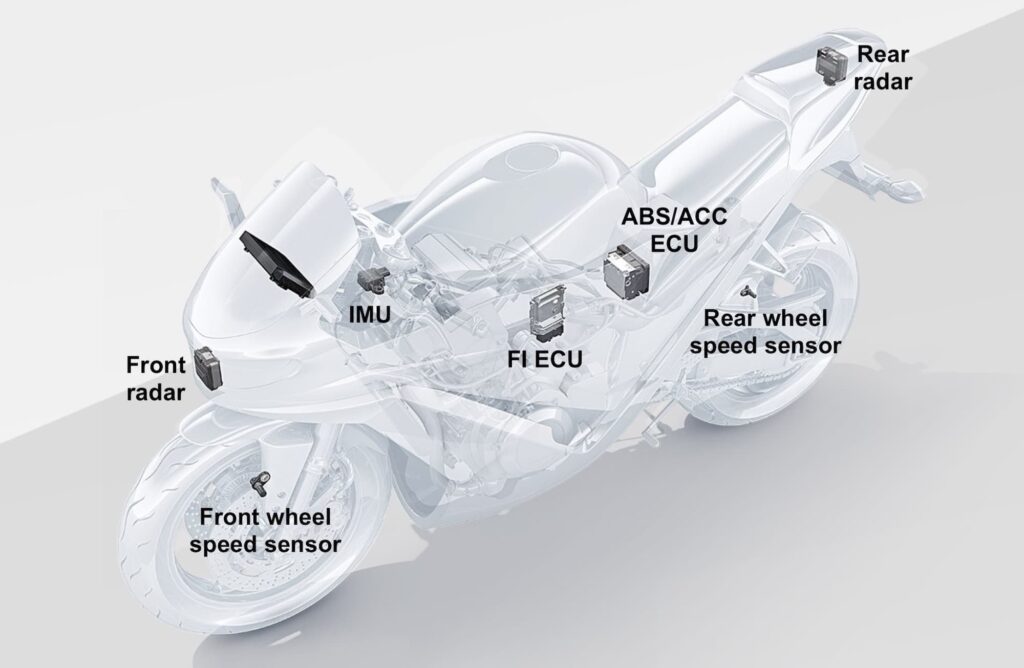
Are you obsessed with motorcycles?
Well, I am. That’s why I created this site — as an outlet. I love learning and sharing what others might find useful. If you like what you read here, and you’re a fraction as obsessed as I am, you might like to know when I’ve published more. (Check the latest for an idea of what you’ll see.)
How Adaptive Cruise Control Works In General
Firstly, as with an IMU / cornering ABS, an adaptive cruise control system is better described as part of the motorcycle’s overall safety and control system. It’s an extension of an already complicated system.
To simplify it extremely, adding an ACC system to a motorcycle means adding a control module and radar emitters and sensors to the ECU units that control everything.
When the motorcycle’s ACC system detects that you’re approaching another vehicle too quickly, or that you’re already too close to one, it backs off on the cruising speed until you’re at a safe distance. It also detects when a vehicle in front of you is going more slowly than you, and uses that as an input (whether to slow down, or to set off an alert).
But the safety control system doesn’t just take inputs from the radars. It still takes input from everything else on the bike — the inertial measurement units, the wheel speed sensors, and of course the engine. All of those are important inputs for the cruise control and related systems.

The physical parts that you add to a motorcycle to give it adaptive cruise control are:
- Radars, front and rear (one each)
- An ACC computer
- An interface with the engine and display
Here’s how Kawasaki represents their safety systems, which include active cruise control (and many other things) on the 2022 Ninja H2 SX SE, their premium supercharged 200 hp everyday bike that stretches both the definition of “sport tourer” and your arms out of their sockets.
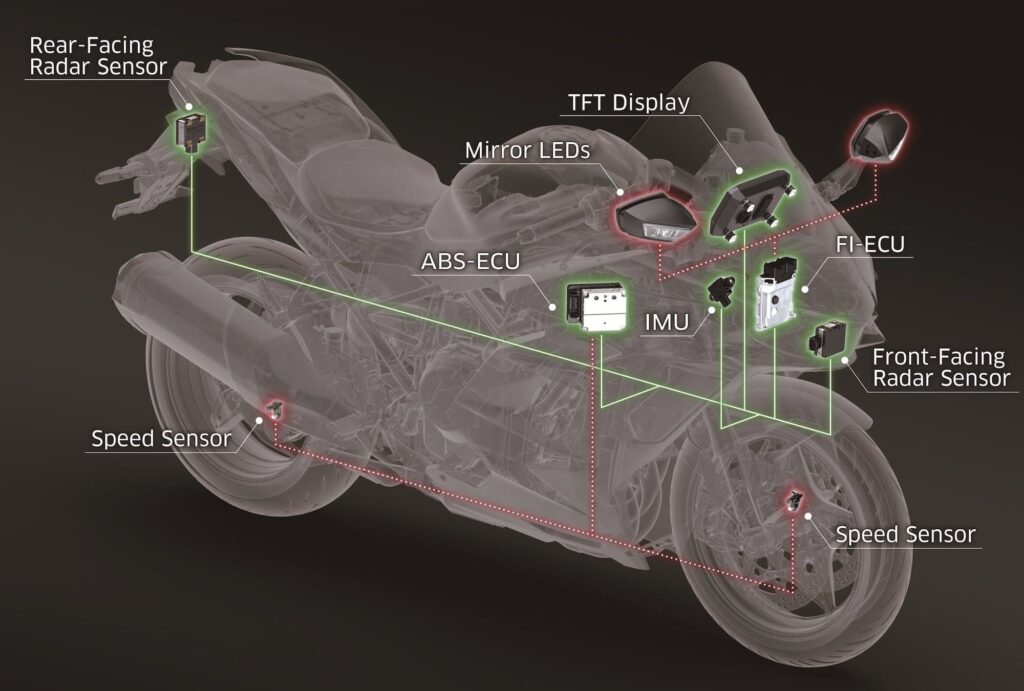
The core additional components of an adaptive cruise control system are the radar/sensor units that are placed in the nose and tail, and the adaptive cruise control computer. Here are the Bosch units.
Kawasaki, BMW, and Ducati all use a Bosch system that Bosch generally classes as radar-based assistance systems (“ARAS”). Bosch has been building these systems for cars and trucks for years.
The parts all come from Bosch, so they look the same between manufacturers at present. Look at the radar unit above from BMW — it looks the same as the one in the Ducati Multistrada V4, as well as the generic one on the Bosch website.
I suspect they’re interchangeable. For now, it’s not like you’d save money by getting a Ducati part and stuffing it into your BMW or KTM motorcycle. But maybe years in the future, when rebuilding a crashed classic, you might be able to get a salvaged Bosch radar sensor from one bike to work in another.
Here’s how Ducati mounts the front radar into the nose of the Multistrada V4.
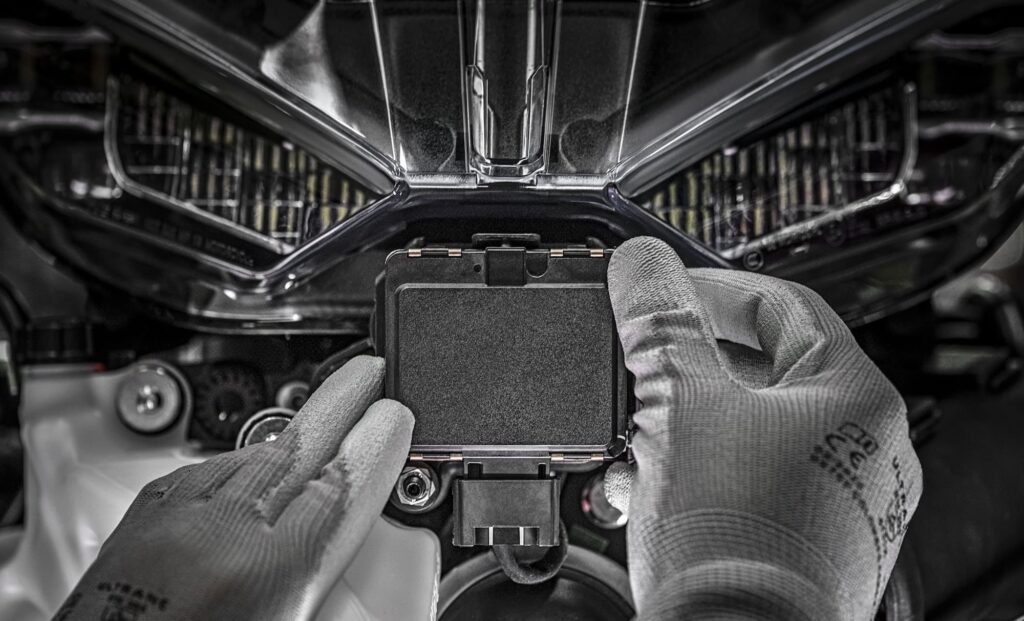
Manufacturers choose the mounting point for a front radar sensor quite carefully. There can’t be any radiation-absorbing materials in front of them (like metal bars).
And what’s more is that even though radar is not on the visible spectrum (unlike a laser for example… or any light), you have to keep the area around the radar clean.
This means you should keep it free of mud, debris, bug splatter, or even dust that accumulates from riding in fog or rain.
The reason for this that that mud or bug splatter might absorb some radiation. This is because of how radar works.
At its most basic, radar works by emitting a pulse of radiation and then listening for when that bounces back from another moving object, as well as for any shift in frequency (that indicates the relative speed of the object as it moves closer or away).
To get an accurate reading, the sensor has to be able to pick up the returned signal cleanly. Because the returned signal is just the bit of radiation that bounced off another vehicle that might be quite far away — maybe 200 feet or 60 metres, at freeway/interstate speeds, the signal received is quite weak. You don’t want dirt or debris making the sensor’s job even harder.
The Bosch adaptive cruise control supports various functions, and all manufacturers implement these functions. These functions are:
- Adaptive cruise (of course): The core purpose of the system! You set a speed and a comfort distance, and the motorcycle keeps to the maximum speed as long as there’s no vehicle within that distance.
- Forward collision warning: this looks for sudden danger ahead, e.g. a stationary object or a car that has swerved into your lane. If you’re going too fast and should emergency brake, the bike will give you a visual and/or audible warning.
- Blind spot detection: This is where the rear-facing radar comes into play. When the system detects a vehicle in the rider’s blind spot, the bike gives you a visual warning.
We’ll look more at how to use these functions on different motorcycles below.
Let’s look a bit more at the main function: active cruise control. What this does on every motorcycle (so far) is fairly similar.
As I mentioned above, in principle, you set the speed and let the system figure out if it’s safe to keep going at that speed. If a vehicle is going more slowly, it keeps at a safe distance; and if that vehicle speeds up or gets out of the way, the bike resumes its speed.
But there’s a lot of nuance to how you ride a bike. Like, for example, what happens if you go around a corner?
When you ride around a curve, the ACC system reduces the bike’s speed, aiming to keep the motorcycle at a comfortable lean angle.
On top of that, as your lean angle increases, the bike limits the amount by which it accelerates or decelerates. This is so that you won’t be surprised by sudden braking or acceleration.
For example, if you’re going around a corner, and the bike is going more slowly because of a car in front of you, but then that car speeds away suddenly, the bike isn’t going to lurch forward — it’ll be much more gentle while you’re leaned over.
What Adaptive/Active Cruise Control Doesn’t Do
Like any rider safety system, adaptive/active cruise control isn’t something you should rely on to save your life.
Motorcycle manufacturers are very quick to remind riders that you can’t rely on adaptive cruise control as a life-saving device. You’re the one who twists the throttle, applies the brakes, and steers the bike.
This also applies to the front collision warning system that comes with ACC. If you get an alert that you’re approaching something too quickly, it’s up to YOU to apply the brakes or to swerve. Emergency braking depends on the user.
Paraphrasing the manuals of motorcycles with the systems, the active cruise control and front collision warning systems are also limited in how well they work when
- The environment limits the system, e.g. when you’re passing through heavy rain, fog, snow, steam, or smoke. This messes up the radar.
- You’re riding in very winding or curvy roads, or undulating roads (hilly areas)
- You’re riding in areas with lots of radar-reflecting objects, like in a tunnel, or in a parking lot, or just with lots of road-side objects, like mates with cameras
- You’ve heavily modified the tires or wheels
- The radar sensor is covered in dirt, dust, or mud because you’re too “adventure”
- The radar system has been hit by a strong impact
- There’s electromagnetic interference (that messes with the radar signal)
- You’re riding in an unconventional situation — e.g. in a staggered group ride, overtaking quickly, or doing wheelies and stoppies (aha, the Kawasaki manual acknowledges you might be doing this!), or even when lane-splitting (remember, it’s legal nearly everywhere in the world other than most states of the US)
- You’re crossed by an animal suddenly. Or even by car in an intersection
- There are flying objects around, e.g. balls or plastic bags (it literally says this in the BMW R 1250 RT manual… “balls or plastic bags”)
- The bike runs too hot
- The motorcycle gets annoyed with you because you’re riding weirdly (ed: I added this one, because it’s why I feel my bike acts up sometimes)
Adaptive cruise control systems only work with large-ish objects that are going in the same direction. They don’t reliably pick up
- Cyclists
- Animals
- Vehicles that are stationary or moving in the opposite direction
- A vehicle entering from the side (until it’s picked up)
Get the idea? It’s just an aid. You’re the one who remains in control.
How to Use Adaptive Cruise Control on Various Motorcycles
So, you’re test riding a motorcycle worth more than my entire collection of bikes and you want to put this wizardry to use (this is the situation I was in). How do you use adaptive cruise control and test out whether it’s working?
In principle, you use adaptive cruise control exactly as you do regular cruise control. Once you hit a speed you want to, you hit cruise to let the motorcycle take over the throttle function.
But the nuance with adaptive cruise control is that it doesn’t just set your speed and forget it; it also regulates your speed if a vehicle in front of you is going slower than you’d like.
So there are two things you have to set with active cruise control
- Your cruising speed — which you set when riding
- The follow distance — which you either set while riding or when you have time to dive through the screens.
You can also set a few other settings from the menus, like how active you want the cruise to be in adjusting its speed.
You can also use your active cruise control as standard (non-adaptive) cruise control, anyway. This is more something to think about when you own a motorcycle long-term. Sometimes you may ride through countries where your radar isn’t licensed to operate. In those cases, you dive through the menus, turn active cruise control off, and use cruise control as normal.
Manufacturers have different ways of setting the comfortable follow distance of the active cruise control system.
- BMW: BMW has a dedicated button for follow distance, as you can see in the button above. You can choose between three follow distances. In the manual they give you a hint as to the way they think about adaptive cruise: they call it “Distance Control”. That button is right next to the cruise control switches. You can set it between three distances: short, medium, and long, but the manual doesn’t say what those mean exactly.
- Ducati: Along with the cruise speed buttons, Ducati has dedicated “+” and “-” buttons to increase and decrease follow distance. You can set it between four levels, corresponding to around 0.8 to 2.0 seconds
- KTM: Under the Cruise Control / ACC Distance menu, you can set between five follow distances, from “very short” (~0.9 seconds) to “very long” (~2.0 seconds).
- Kawasaki: Kawasaki has a normal cruise button, and you can set the distance from the handlebar by using the ‘fn’ button at the same time as the bottom option button. It’s not intuitive just from looking at the buttons.
When you set the follow distance, all the manufacturers have a way of showing the follow distance on the screen. Generally, it’s some variant of what BMW shows (below). There are symbols for
- The follow distance set (from short to long)
- Whether there’s an object being tracked
- Whether there’s a hazard detected (and you need to take emergency evasive action) — either a red or yellow symbol, flashing
- Whether there’s a fault and the ACC system can’t operate for some reason
To disengage/cancel active cruise control, there are usually three options available on any motorcycle (check your motorcycle to confirm you have these)
- Tap the brakes (this is usually the quickest)
- Switch the cruise system off with the button / switch you have available
- Hold the clutch in for 1-1.5 seconds. (Note — on earlier models of motorcycles that have regular cruise, you just have to tap the clutch open. On motorcycles with active cruise, the manuals I’ve read say you have to hold the clutch in.)
- Rotate the throttle forward, past its normal rest stop.
Like I mentioned, not every bike has every one of these — but usually, they have a few of them.
One interesting thing is that on motorcycles with electronic quick shifters (most of the bikes in this list), you can shift gears and it won’t disengage adaptive cruise control, as long as you use the quick shifter.
BMW Motorcycles with Active Cruise Control — R 1250 RT, BMW R 18 Transcontinental / Bagger, R 1300 GS
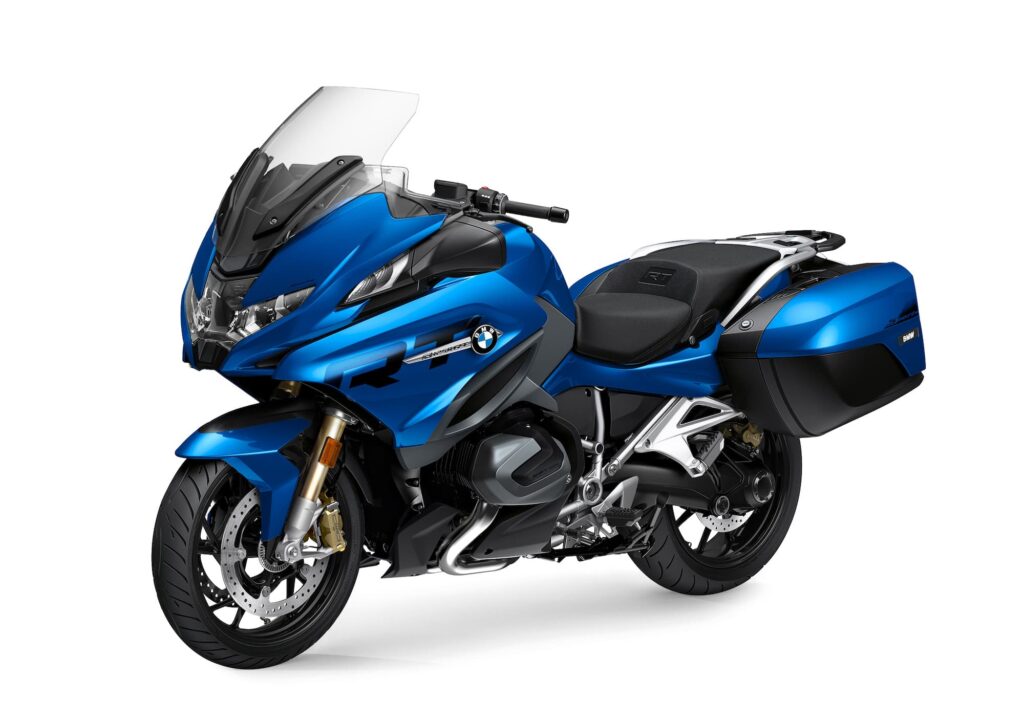
BMW first announced that the 2021 model of the BMW R 1250 RT would have adaptive cruise control.
BMW has also given adaptive cruise to the BMW R 18 Transcontinental and Bagger, its two full-fat versions of the R 18 cruiser. They’re similar, but the Transcontinental has a top box and a taller screen.
Check out the dash and instrument cluster of that bad boy. Big air-cooled engine, yes, but also you’re piloting a starship.
The ACC system on the three BMW motorcycles works with a front-mounted radar only. They don’t have blind spot monitoring.
Since three BMW motorcycles have been graced with ACC, BMW owners have been wondering when it’s going to get to the other high-end bikes. So far, no news about the K 1600 high-end touring bikes, the rest of the R 18 line, or the S 1000 XR — all of which I think are prime candidates for ACC, just in terms of where they sit in the product lines.
See the model guide to the BMW S 1000 XR.
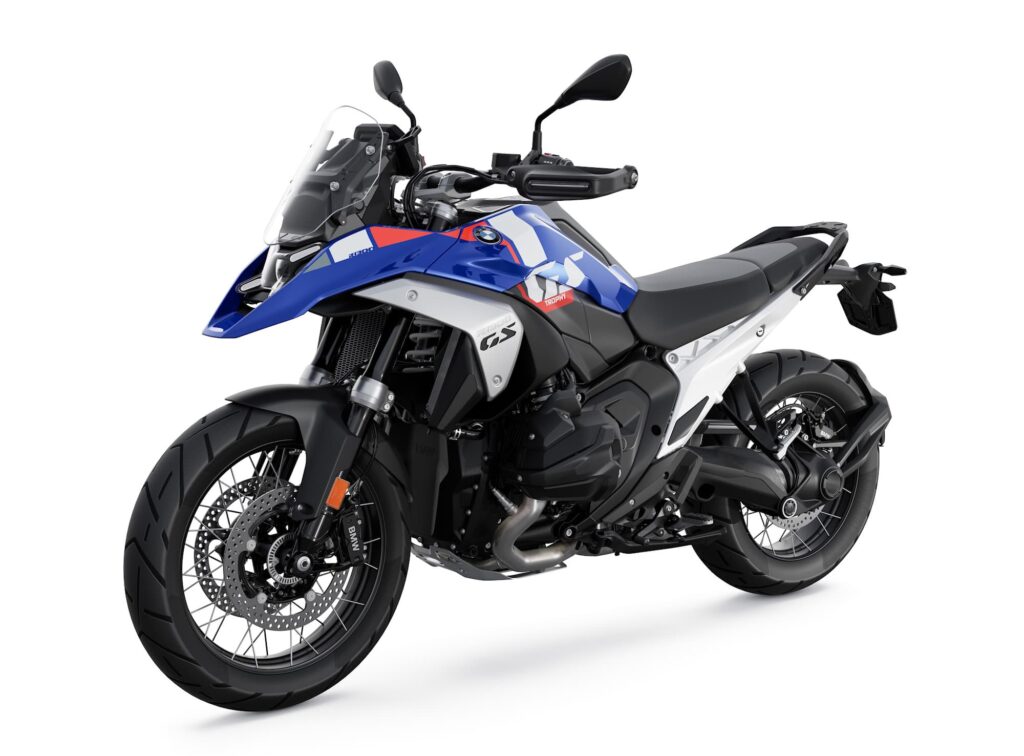
The 2024+ BMW R 1300 GS also has active cruise control — the R 1250 GS never received it, despite the R 1250 RT having received it.
See the BMW R – GS model buyer’s guide.
Ducati Motorcycles with Adaptive Cruise Control — Multistrada V4 (Various trim levels)
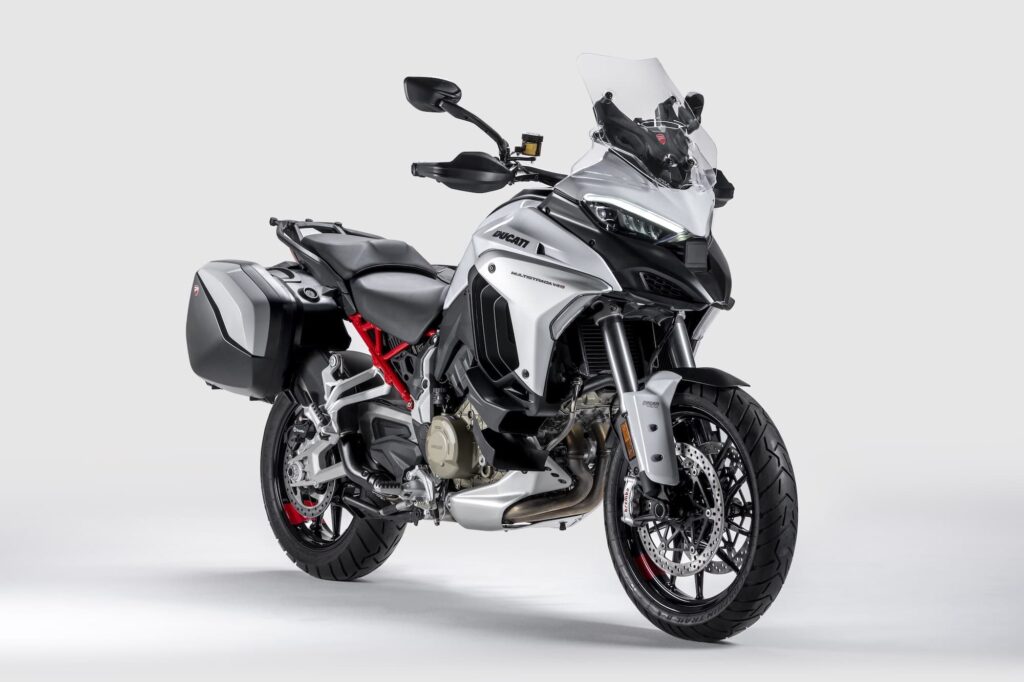
For now, only the Ducati Multistrada V4 has adaptive cruise. It has had it since the 2021 model year, though early owners only could activate it some time after purchase. It has been standard since the 2022 model year.
The Ducati Multistrada V4 was actually the first motorcycle on the market with adaptive cruise control, but the difference in timing was minor (just bragging rights).
The Ducati Multistrada V4 is Ducati’s top-level adventure touring bike. It’s the latest in a long line of bikes that started with the 2003 Ducati Multistrada 1000DS, which had an air/oil-cooled L-twin engine. Ducati gave its premium tourer the V4 engine in 2021. It’s not just the Panigale V4’s engine but “detuned”, it actually is different — called the “Granturismo” engine is the first Duc engine in a while to give up the Desmoquattro design, using more common spring-driven valves again.
Even without desmodromic valves. the V4 engine still revs like a demon for a big engine, making a peak of 170 CV (168 bhp, 125 kW) at 10500 rpm. And the icing on the cake is really wide maintenance intervals of 37000 miles / 60000 km for valve inspections.
The specific models of Multistrada V4 with the radar-enabled adaptive cruise control varies by region. In some it’s the V4 S, in some it’s the V4 but with the “radar” package. I’m sure there are other variants.
Since the Multistrada V4 is the premium adventure tourer and the only tourer in the line-up (Ducati don’t make a sports tourer… the Supersport is more an everyday sport bike), I’m not sure what other bikes Ducati might bring active cruise to. Maybe the XDiavel, but I don’t know.
Using adaptive cruise control on the Multi V4 is exactly the same as on the base model — you just press the “on” button with your thumb while riding at any speed between 30 and 160 km/h (18 and 98 mph).
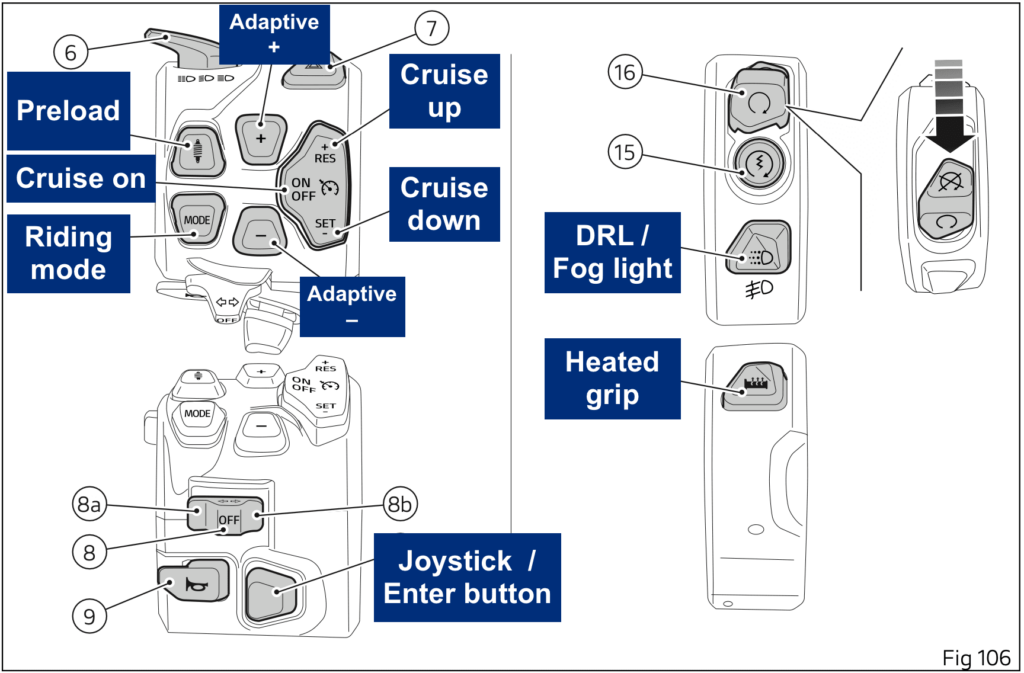
The main difference is that you also have buttons to set your buffer zone between your motorcycle and other vehicles.
The easiest way to set cruise distance is with the adaptive + and – buttons, next to the cruise control toggle. There are four settings:
| Setting | Distance (meters/feet) | Time (seconds) at 100 km/h (62 mph) |
|---|---|---|
| Near | 22 meters (72 feet) | 0.8 seconds |
| Medium | 34 meters (112 feet) | 1.2 seconds |
| Far | 44 meters (144 feet) | 1.6 seconds |
| Very far | 55 meters (180 feet) | 2.0 seconds |
Interesting side note. The Ducati Multistrada V4’s radar-guided overtaking assistance is calibrated for right-hand driving or left-hand driving. So it’s a setting you may need to change if you travel internationally, e.g. from the UK to Europe, or from Australia to as far as you can swim…
Kawasaki — Ninja H2 SX (2022+)
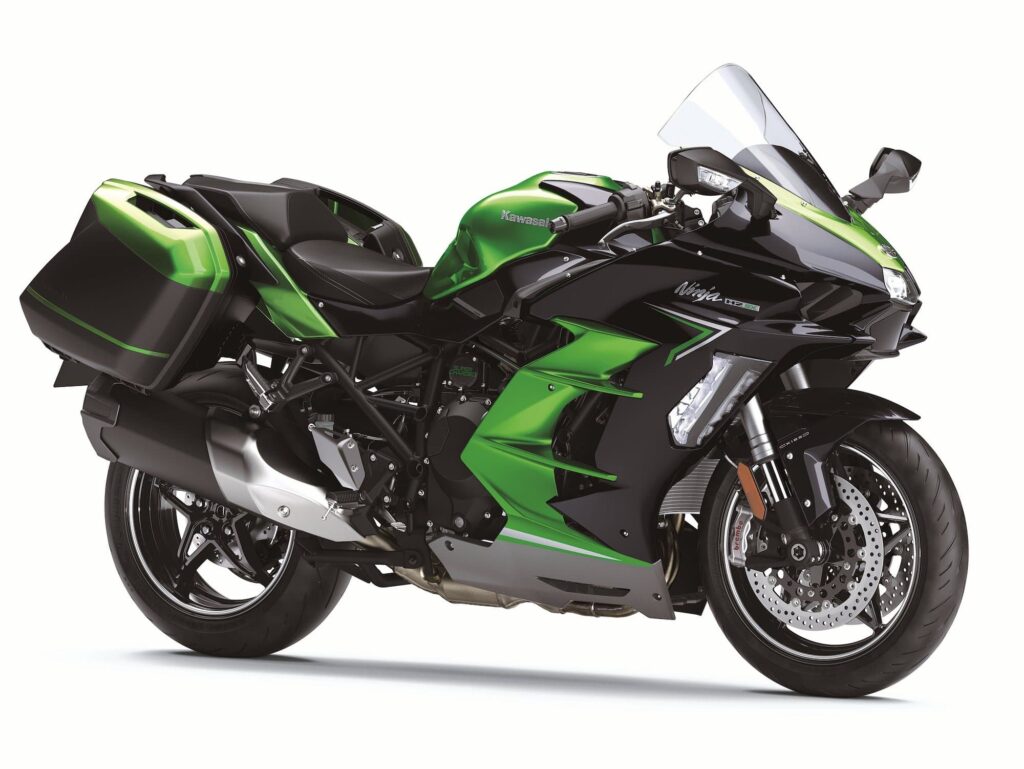
Kawasaki’s first model to get adaptive cruise control (as well as blind spot monitoring and forward collision alerts) is the Kawasaki H2 SX, the high-speed sport tourer that’s part of the supercharged Kawasaki H2 series.
The Kawasaki H2 SX is the more accessible sport tourer, made for everyday riding, despite the very high power number. Riders don’t notice the huge power on tap unless you dare to pin the throttle and hold it there for a long time. Otherwise, like many Japanese high-powered sport tourers, it’s very easy to ride.
Kawasaki has for a long time been the Japanese manufacturer to bring high-tech features to everyday motorcycles earlier than the others. This was true with ABS, Traction control, and even cornering ABS (the consumer-oriented 2017 Kawasaki Ninja 1000 had cornering ABS).
They’re repeating the same pattern with adaptive cruise control. I’m hoping to see active cruise on the more accessible sport bikes as well, like the Ninja 1000 (though that did only just get cruise control from 2020). I’d expect to see it first on the Kawasaki Versys 1000.
KTM motorcycles with Adaptive Cruise Control
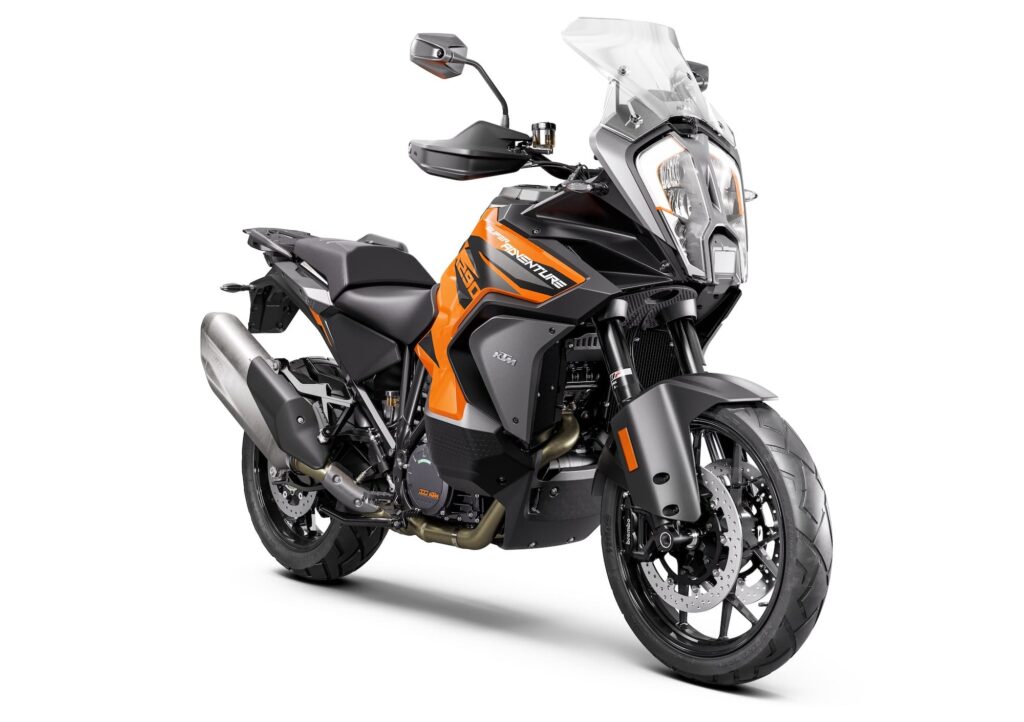
The 2021+ KTM 1290 Super Adventure S has active cruise control.
The Super Adventure S is the street-oriented super tourer in the Super Adventure line. KTM also makes the Super Adventure R, with more off-road touring gear (for example a 21-inch front wheel), but the SAR doesn’t get active cruise control just yet.
There’s a lot that’s high-tech about the SAS — semi-active WP suspension, a 7-inch TFT display, and of course the full Bosch safety suite.
But the jewel of the KTM 1290 Super Adventure S is the same as other 1290 motorcycles: the beastly 1301 cc liquid-cooled 75-degree V-twin that makes a peak of 118 kW (158 bhp / 160 CV) at 9000 rpm.
KTM doesn’t have a sport tourer (that’s the SAS’s duty), but I do wonder when active cruise may make it to the 890 adventure range.
Moto Guzzi Stelvio (2024+)
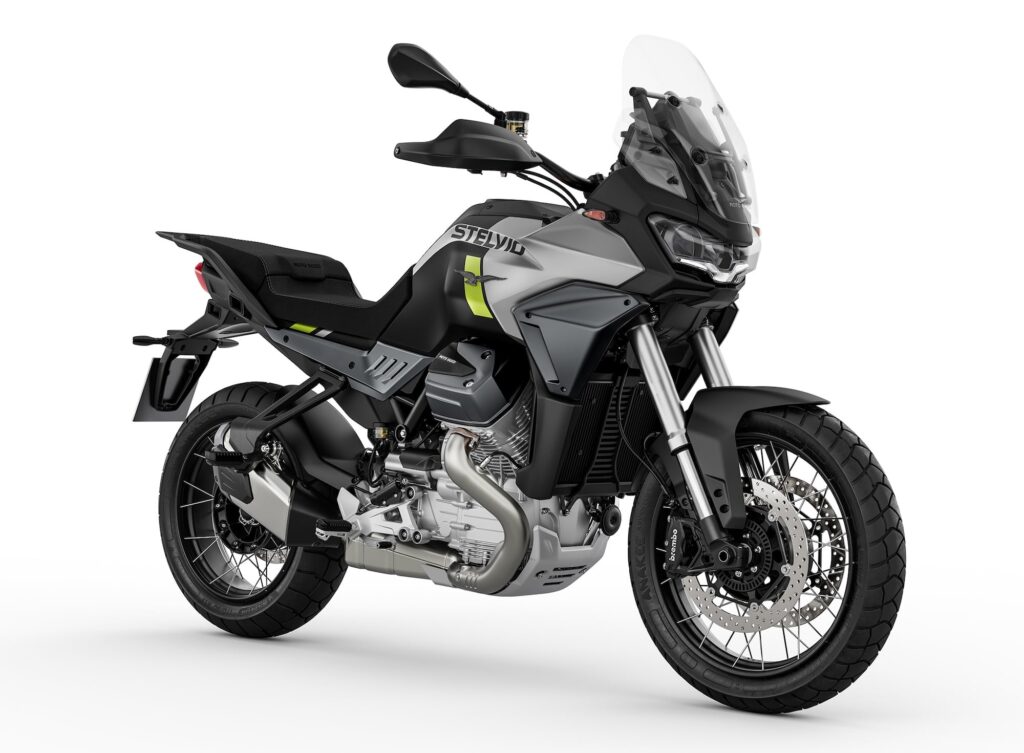
Moto Guzzi’s re-release of the Stelvio (announced at EICMA 2023), based on their relatively new liquid-cooled V-twin (previously seen on the V100 Mandello), also has adaptive cruise control (as an option), lane change assist, and the works.
Moto Guzzi’s active cruise control is called the “PFF Rider Assistance Solution”, which uses “4D imaging radar”. PFF stands for Piaggio Fast Forward, a Boston-based research company under the Piaggio group (which owns Moto Guzzi).
Piaggio Group also owns Aprilia, so we might see this tech on some high-end Aprilia motorcycles, too. (And who knows? Maybe even on a Vespa!)
Yamaha MT-09 Tracer 9 GT+ (2023+)
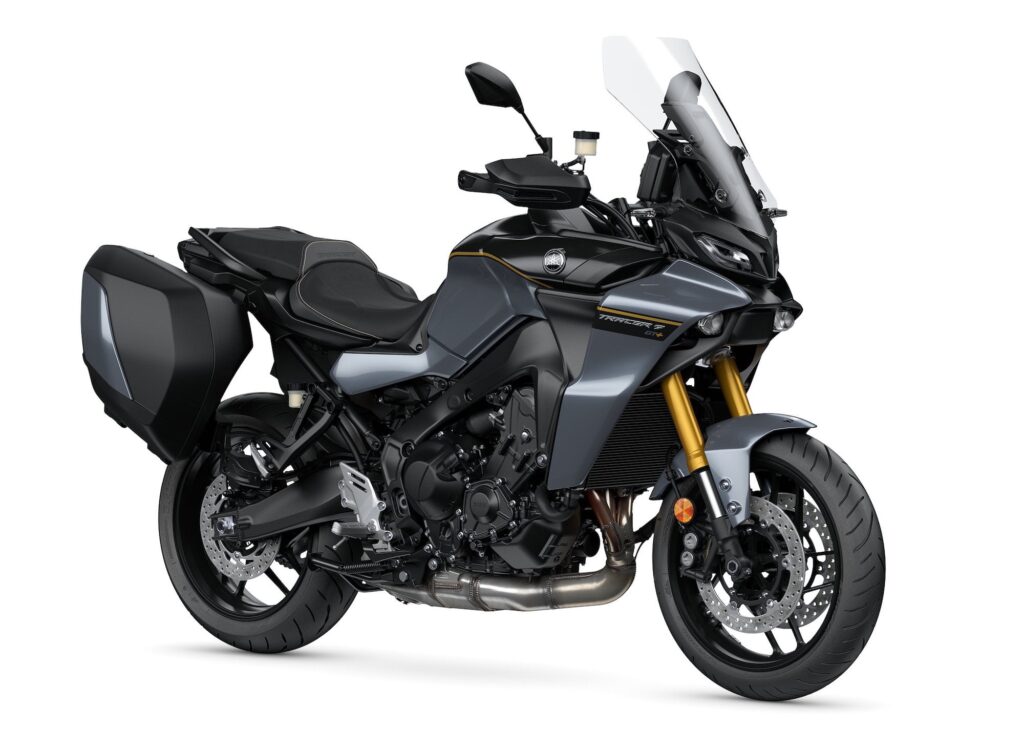
Earlier in 2022, some sleuths at RideApart spotted a Tracer 9 GT being tested with radar sensor units. Yamaha confirmed in November 2022 that the 2023 model Tracer 9 GT+ (a new model designation) would have adaptive cruise control, but only in Europe. From 2024, it came to more markets, including Australia and the US.
The Yamaha Tracer 9 GT+ is the first relatively affordable middleweight motorcycle with adaptive cruise control. Very interesting move! The Tracer 9 GT (without +) is “affordable” for its class (of middleweight sport tourers), that is, and certainly cheaper than other motorcycles in this list for the 2023 model year. The GT+ will also definitely punch under the weight of the Multistrada V4S, for example.
The Tracer 9 GT+ is also unique because while it’s a relatively “premium” bike (already with active suspension and an IMU), it has a middleweight engine — an 890cc triple.
Note that the standard trim Tracer 9 GT, which is sold alongside the GT+ for 2023, and which still has a lot of bells and whistles (including active suspension and standard cruise control), does not have adaptive cruise control.
The Yamaha Tracer 900 / 9 models have been updated much more often than the sport cruising stalwart of the Yamaha line, the FJR1300. I suspect the FJR’s days are numbered.
See more in the rider’s guide to the Yamaha Tracer 900 / 9.
In the Works — Brands that haven’t yet released adaptive cruise control systems on motorcycles
What’s kind of surprising is that some brands haven’t released any motorcycles with adaptive cruise control — even when some are releasing multiple, and when Yamaha has it on a middleweight.
Harley-Davidson Motorcycles with Adaptive Cruise Control — coming very soon?
Harley-Davidson has also filed a patent for adaptive cruise control, showing maybe they don’t want to use the Bosch system. But it hasn’t released any with adaptive/active cruise yet.
With the list of advanced tech features on the Harley-Davidson Pan America (like adaptive ride height, I’d expect that to be the first candidate.
Harley-Davidson has had cruise control features for a while, too.
Honda Gold Wing / Africa Twin (beyond 2024) (Unconfirmed)
There’s a rumour that the next-gen Gold Wing and Africa Twin will have adaptive cruise control.
Germany’s Motorrad Online found patents for both front and rear radar systems in both the Gold Wing and the Africa Twin. The Gold Wing’s fairing accommodates the Bosch sensor, but the Africa Twin’s fairing does not, so it’s possible Honda will develop their own.
Indian Motorcycles with Adaptive Cruise Control — coming soon
So far, Indian hasn’t released any motorcycles with radar-assisted adaptive cruise.
But as of mid-2021, it seems that Indian has started to make plans for it, based on some patents they’ve filed.
My first pick would be the liquid-cooled Indian Challenger model range.
Brands that haven’t yet got Active Cruise Control
A few brands are missing from this list. I’ll update them as the list gets shorter!
Suzuki doesn’t have a motorcycle with adaptive cruise. They just updated the Suzuki Hayabusa to the 3rd gen — that would have been a prime candidate. It has a speed limiter, after all. But Suzuki is a little slower to bring premium features to their bikes, which I don’t mind, because it keeps their bikes affordable.
Honda as well. Honda just released their NT1100 sport tourer, which has cruise control, but it’s not active. I would like to see active cruise on the Africa Twin at least, but I don’t expect to for a few years.
And lastly, I was a little surprised to see that CFMOTO has released their 800MT Explore with a rear-facing radar (their “Behind Radar System” or BRS). This gives the new 800MT a few monitoring and warning functions, like lane change warning — but it doesn’t grant the new MT any active cruise feature. Maybe next time.

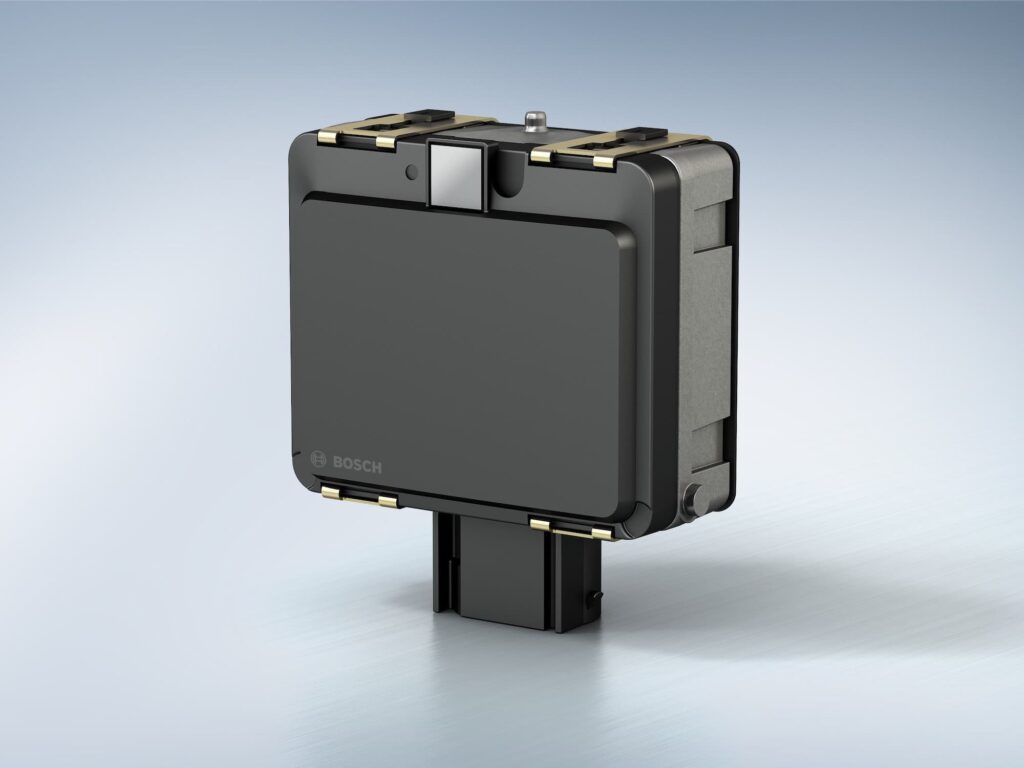
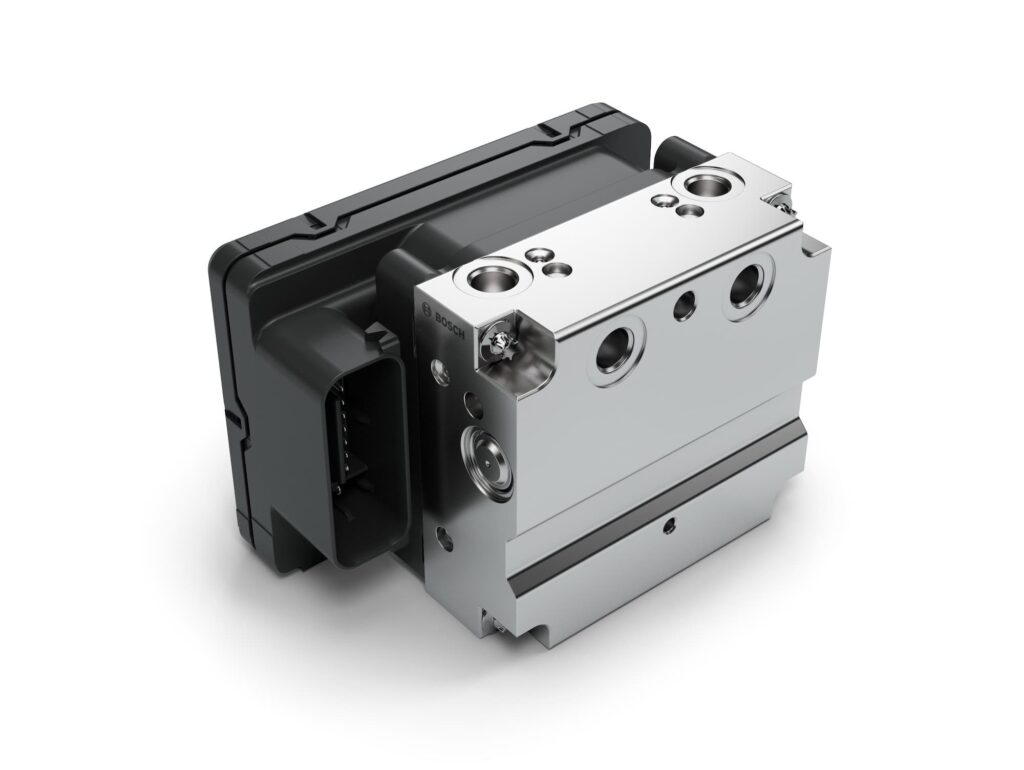
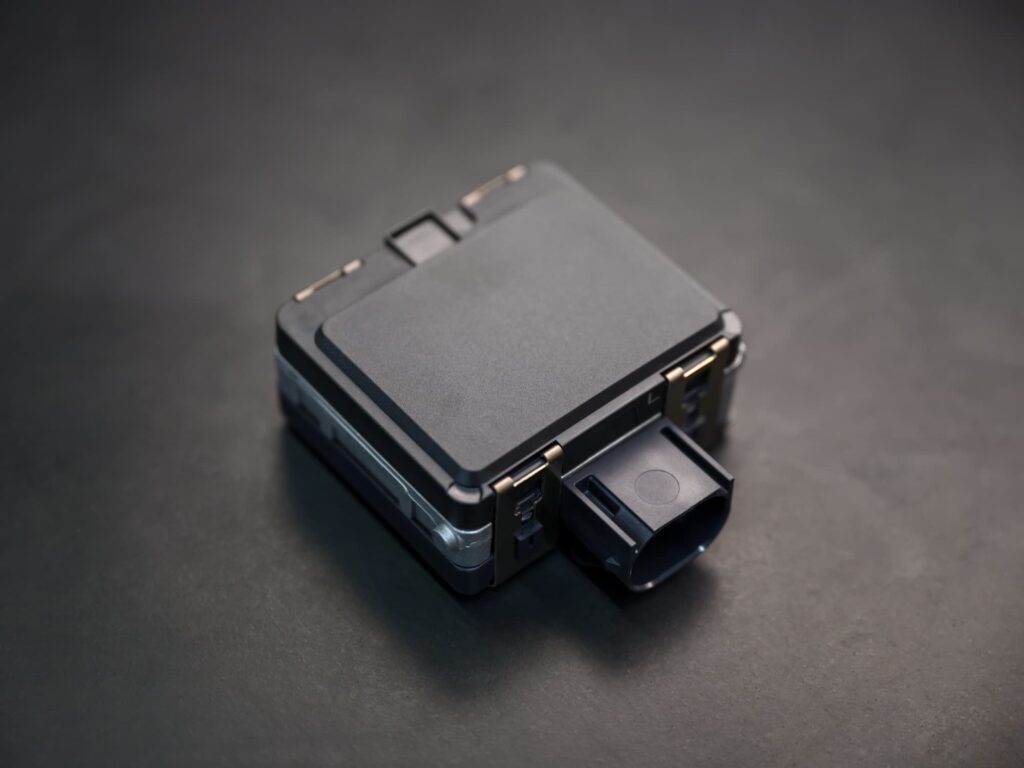
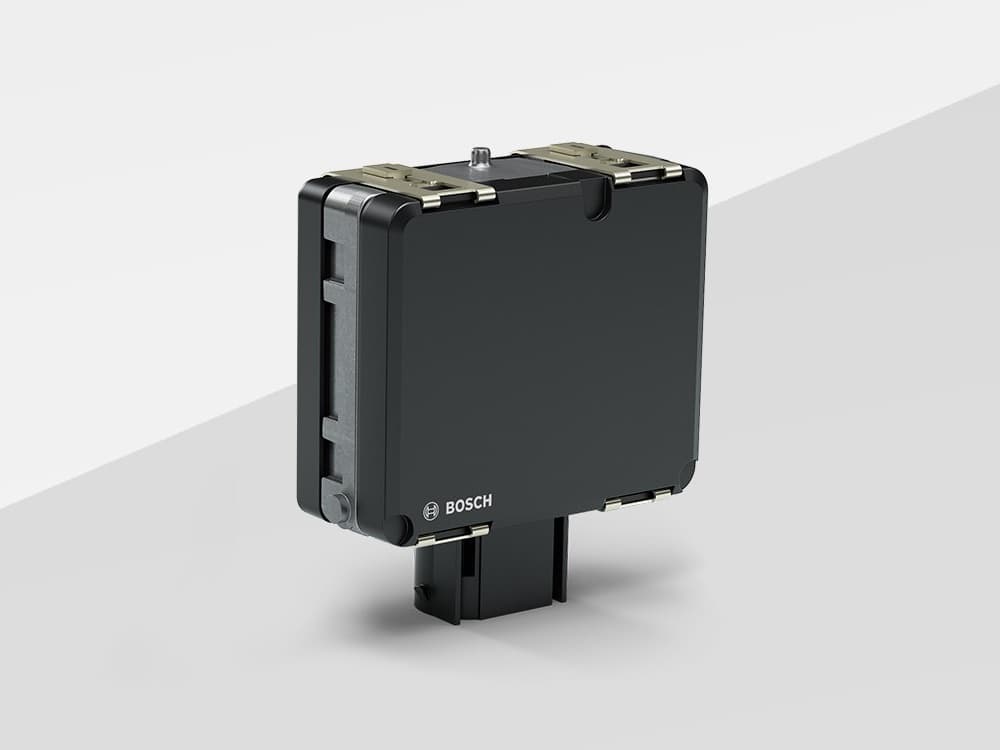
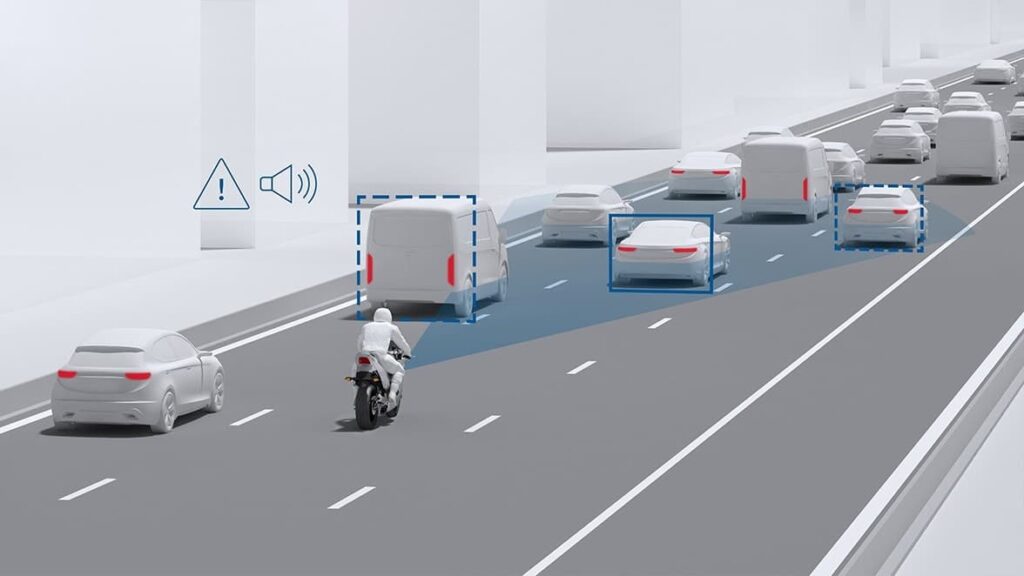
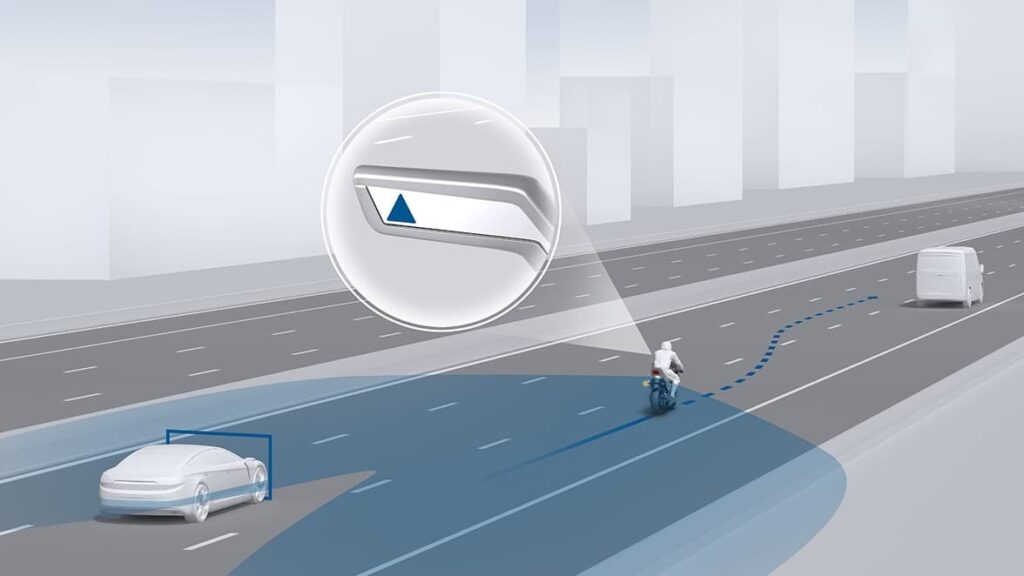
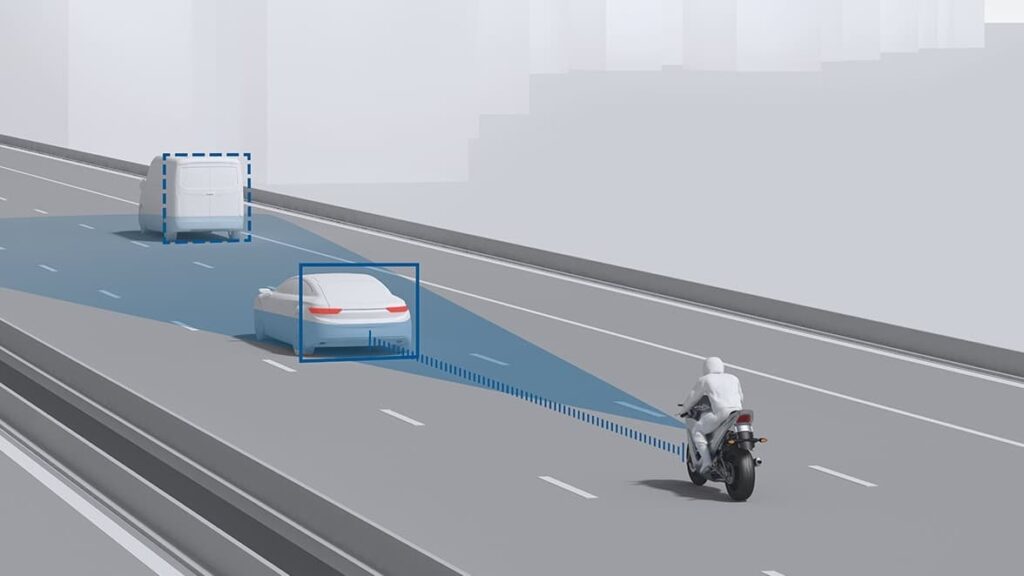
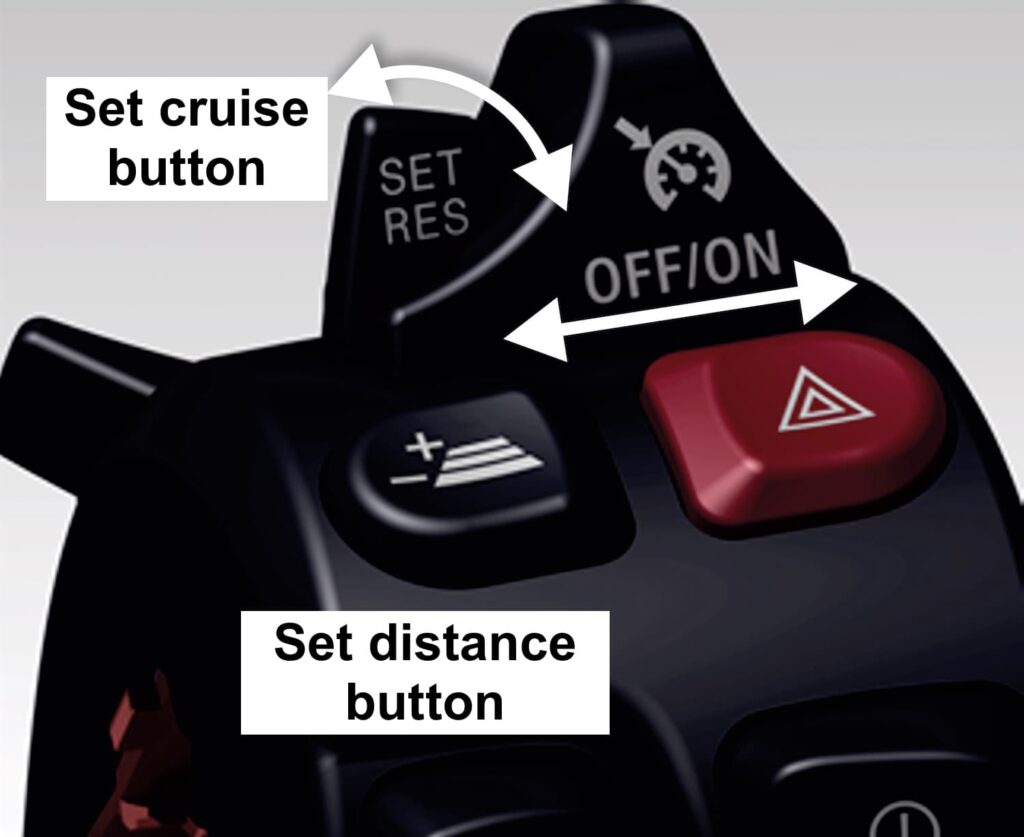
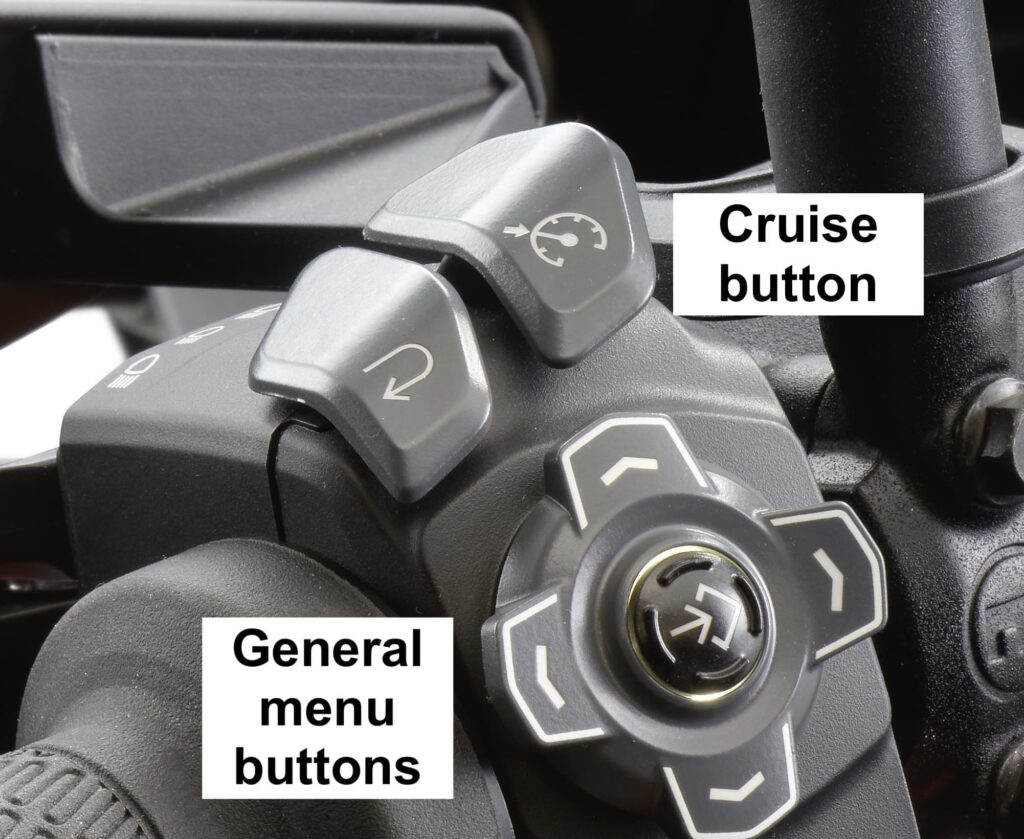
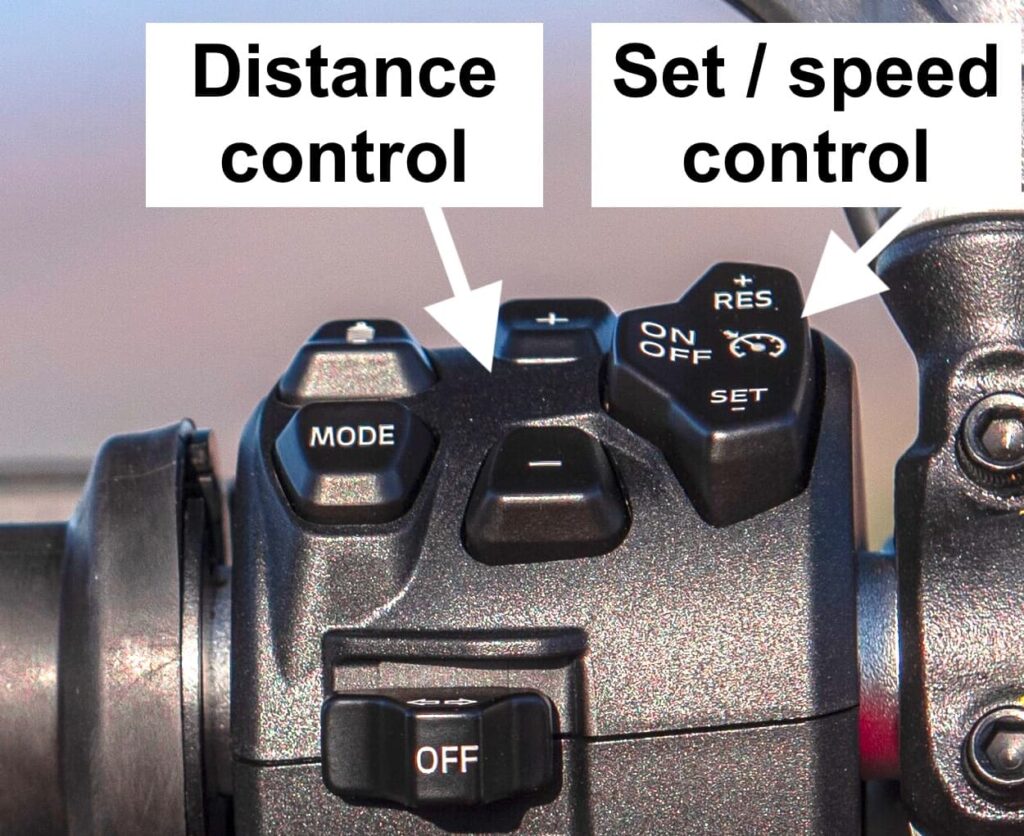
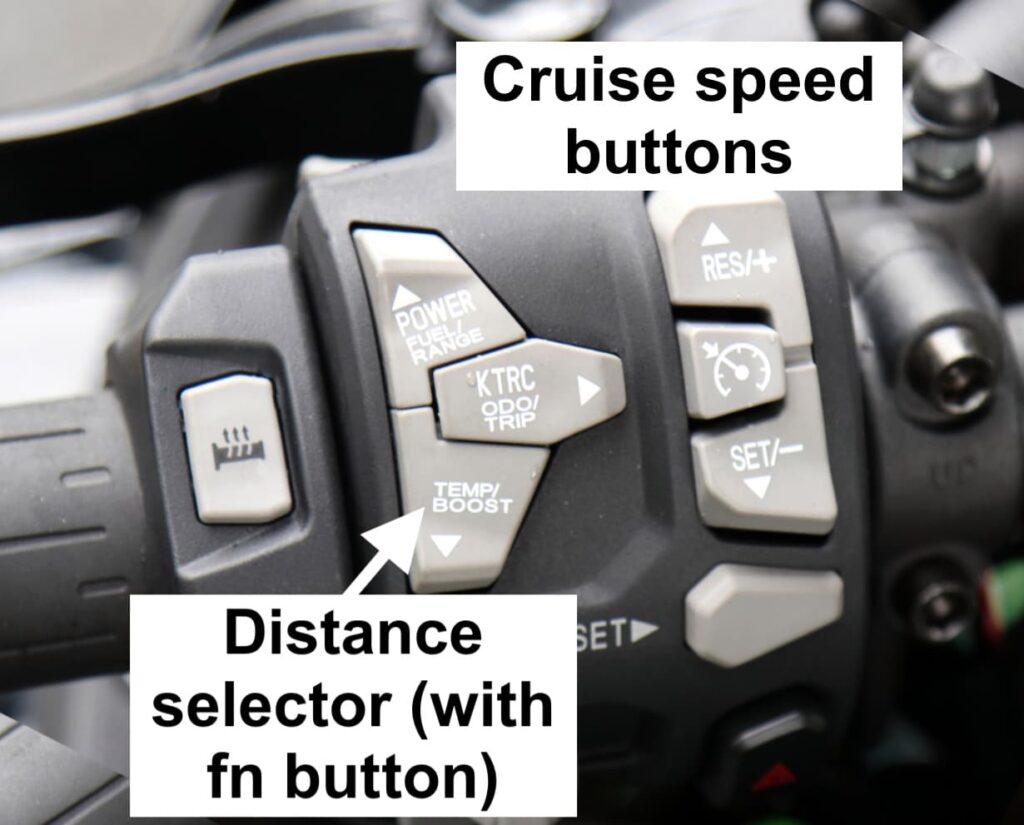
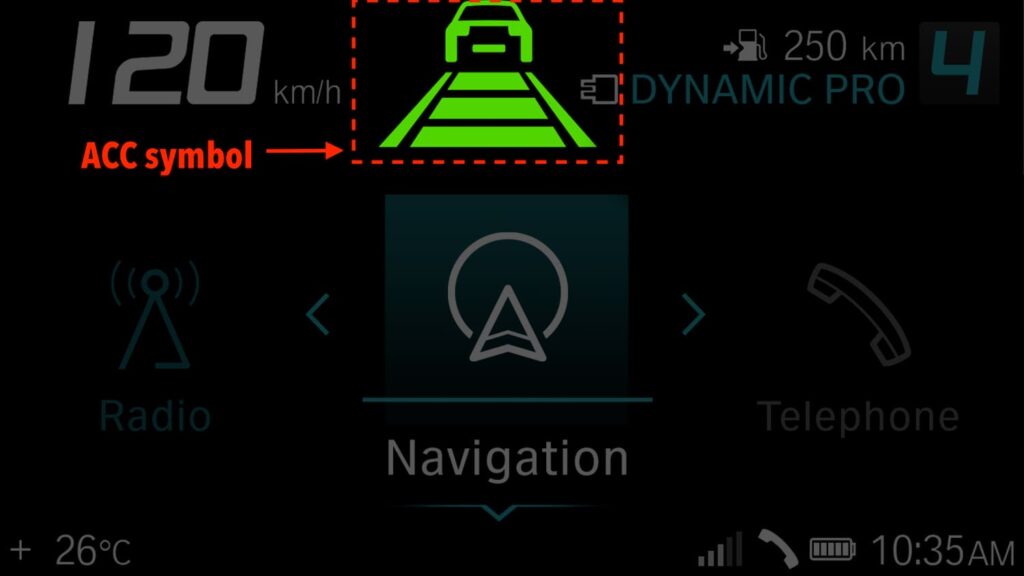
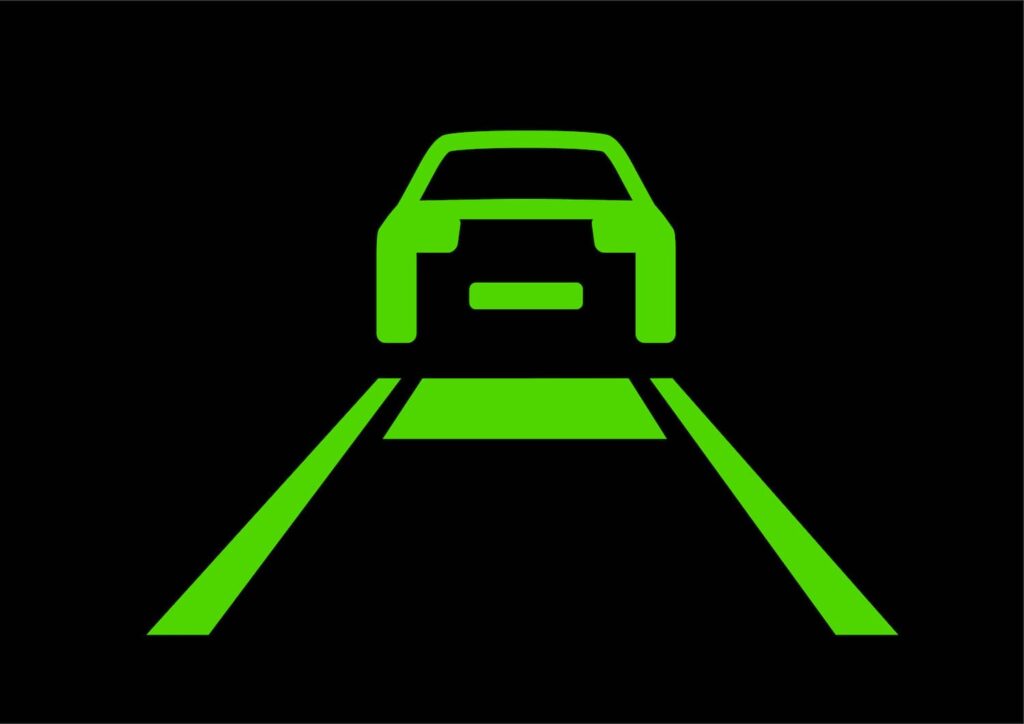
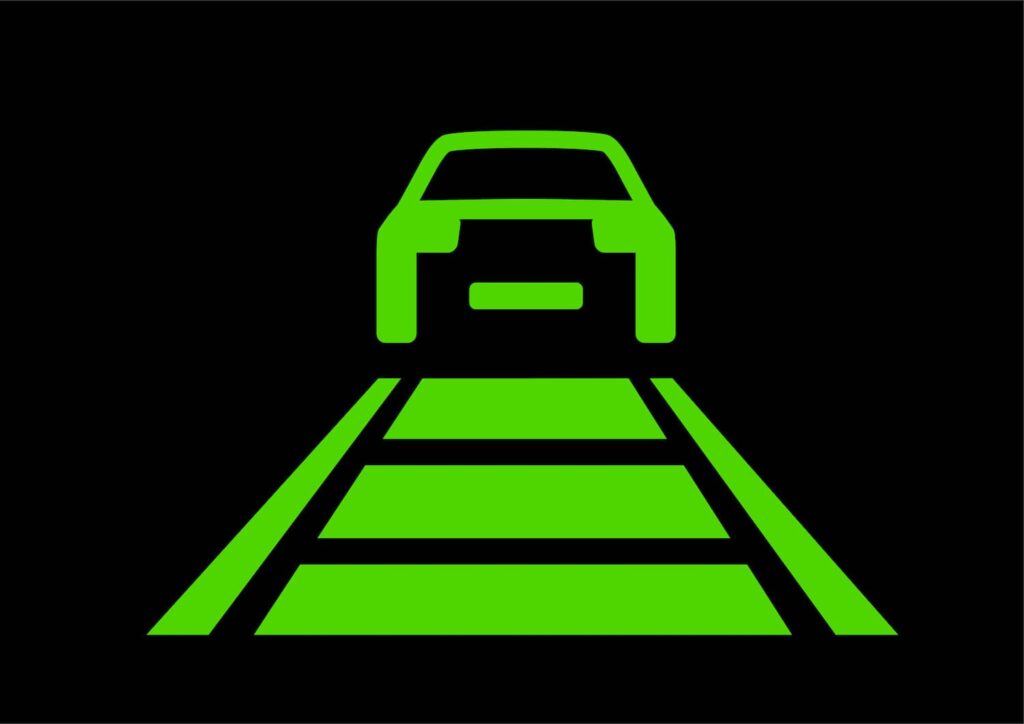
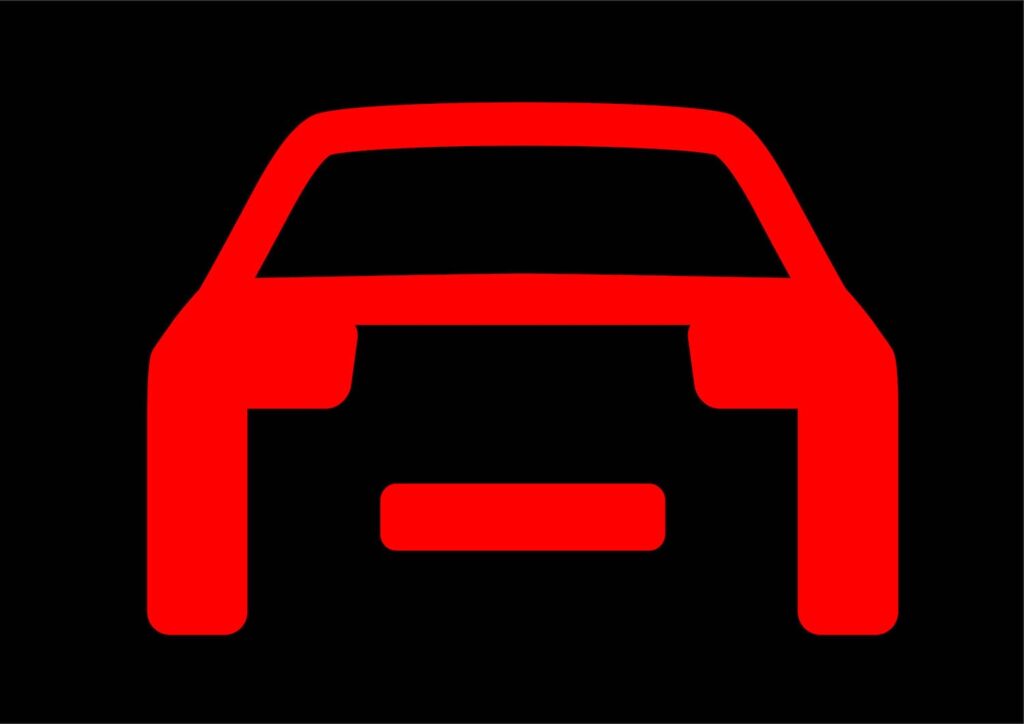
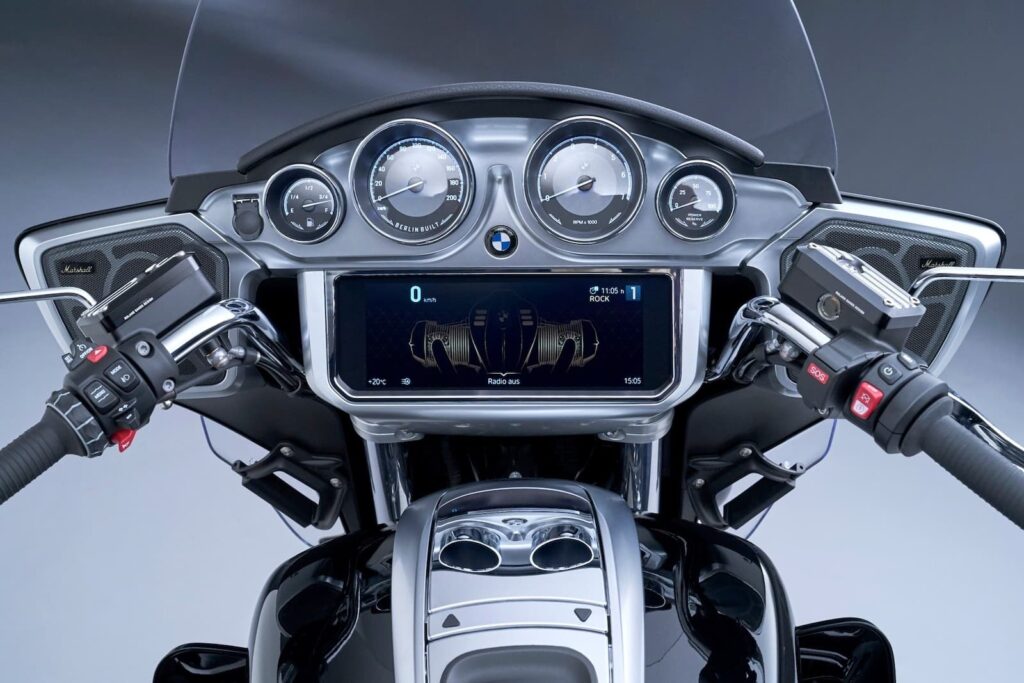
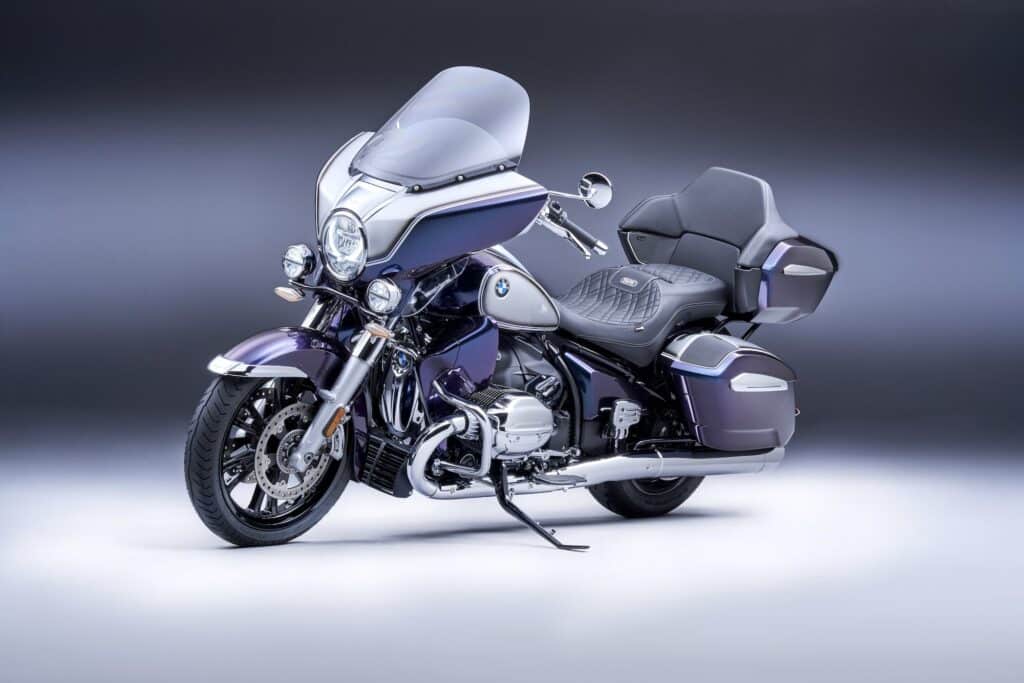
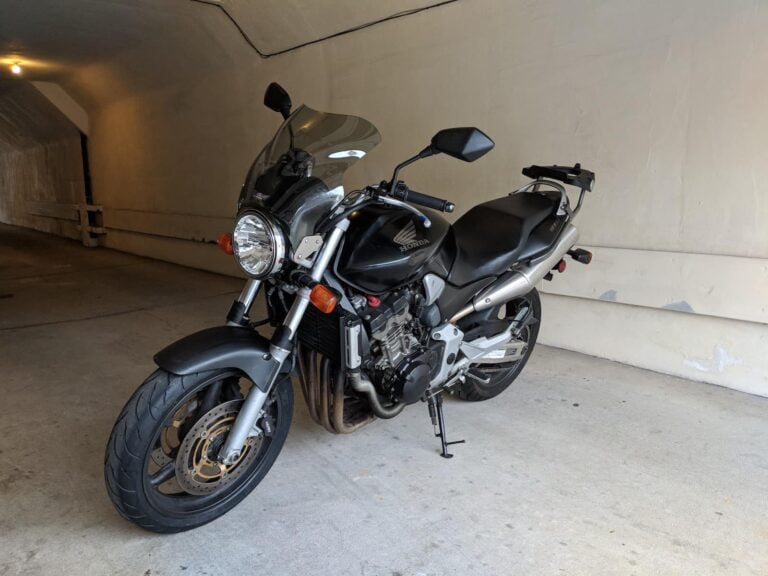
![Triumph Electric Motorcycle TE-1 Prototype — Final Results [Updated] 31 Triumph Electric Motorcycle TE-1 Prototype — Final Results [Updated]](https://motofomo.com/wp-content/uploads/2022/02/Triumph-TE-1-Electric-Motorcycle-Prototype-rhs-side-view-768x512.jpg)
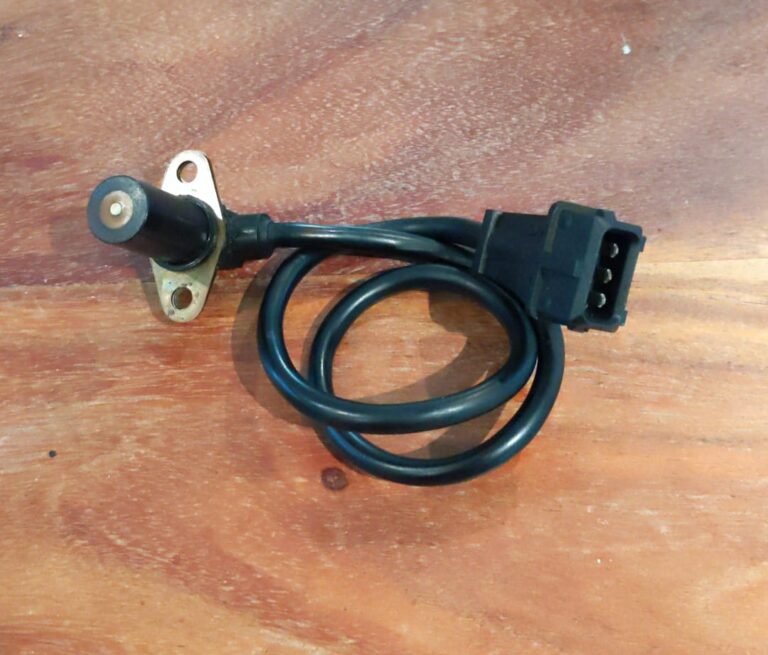
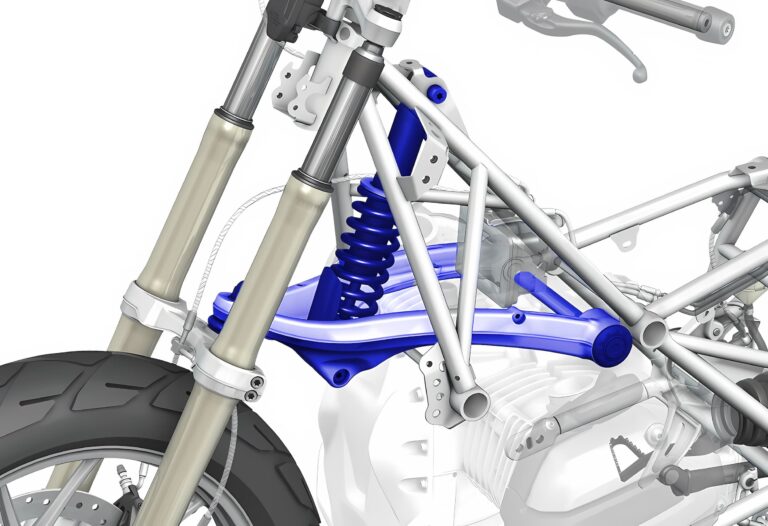
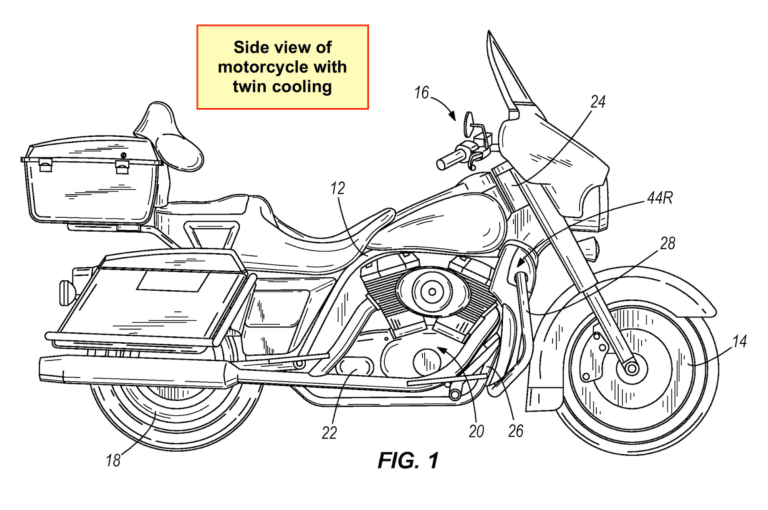
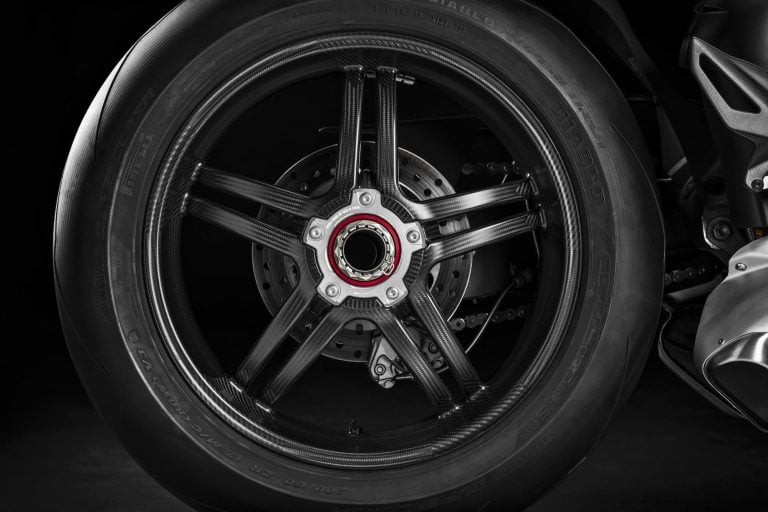
Very nice work mate. Ordered a Ducati V4S travel and radar which arrives in march ( postal strike permitting)
I’m planning on a lot of touring and I am interested to see how useful it is in the real world.
Keep up all your good work and have a nice Christmas matey.
Just adding to the font of knowledge on this very interesting piece –
Piaggio makes the ACC (4D) on the Stelvio… yes, someone other than Bosch makes a cruise control 😉.
Oh yes, that’s a surprise. Just added that detail in.